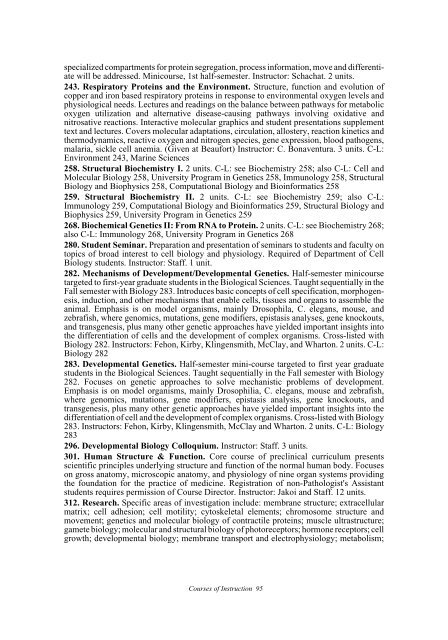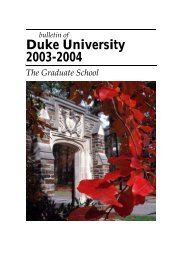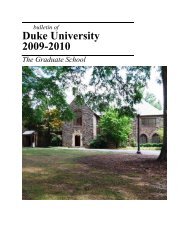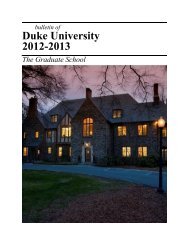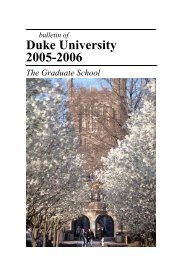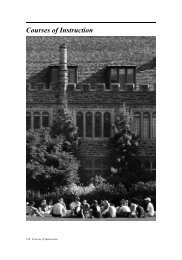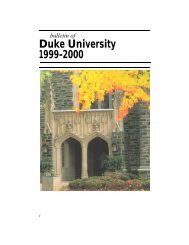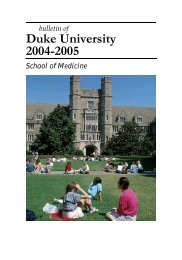Duke University 2008-2009 - Office of the Registrar - Duke University
Duke University 2008-2009 - Office of the Registrar - Duke University
Duke University 2008-2009 - Office of the Registrar - Duke University
Create successful ePaper yourself
Turn your PDF publications into a flip-book with our unique Google optimized e-Paper software.
specialized compartments for protein segregation, process information, move and differentiate<br />
will be addressed. Minicourse, 1st half-semester. Instructor: Schachat. 2 units.<br />
243. Respiratory Proteins and <strong>the</strong> Environment. Structure, function and evolution <strong>of</strong><br />
copper and iron based respiratory proteins in response to environmental oxygen levels and<br />
physiological needs. Lectures and readings on <strong>the</strong> balance between pathways for metabolic<br />
oxygen utilization and alternative disease-causing pathways involving oxidative and<br />
nitrosative reactions. Interactive molecular graphics and student presentations supplement<br />
text and lectures. Covers molecular adaptations, circulation, allostery, reaction kinetics and<br />
<strong>the</strong>rmodynamics, reactive oxygen and nitrogen species, gene expression, blood pathogens,<br />
malaria, sickle cell anemia. (Given at Beaufort) Instructor: C. Bonaventura. 3 units. C-L:<br />
Environment 243, Marine Sciences<br />
258. Structural Biochemistry I. 2 units. C-L: see Biochemistry 258; also C-L: Cell and<br />
Molecular Biology 258, <strong>University</strong> Program in Genetics 258, Immunology 258, Structural<br />
Biology and Biophysics 258, Computational Biology and Bioinformatics 258<br />
259. Structural Biochemistry II. 2 units. C-L: see Biochemistry 259; also C-L:<br />
Immunology 259, Computational Biology and Bioinformatics 259, Structural Biology and<br />
Biophysics 259, <strong>University</strong> Program in Genetics 259<br />
268. Biochemical Genetics II: From RNA to Protein. 2 units. C-L: see Biochemistry 268;<br />
also C-L: Immunology 268, <strong>University</strong> Program in Genetics 268<br />
280. Student Seminar. Preparation and presentation <strong>of</strong> seminars to students and faculty on<br />
topics <strong>of</strong> broad interest to cell biology and physiology. Required <strong>of</strong> Department <strong>of</strong> Cell<br />
Biology students. Instructor: Staff. 1 unit.<br />
282. Mechanisms <strong>of</strong> Development/Developmental Genetics. Half-semester minicourse<br />
targeted to first-year graduate students in <strong>the</strong> Biological Sciences. Taught sequentially in <strong>the</strong><br />
Fall semester with Biology 283. Introduces basic concepts <strong>of</strong> cell specification, morphogenesis,<br />
induction, and o<strong>the</strong>r mechanisms that enable cells, tissues and organs to assemble <strong>the</strong><br />
animal. Emphasis is on model organisms, mainly Drosophila, C. elegans, mouse, and<br />
zebrafish, where genomics, mutations, gene modifiers, epistasis analyses, gene knockouts,<br />
and transgenesis, plus many o<strong>the</strong>r genetic approaches have yielded important insights into<br />
<strong>the</strong> differentiation <strong>of</strong> cells and <strong>the</strong> development <strong>of</strong> complex organisms. Cross-listed with<br />
Biology 282. Instructors: Fehon, Kirby, Klingensmith, McClay, and Wharton. 2 units. C-L:<br />
Biology 282<br />
283. Developmental Genetics. Half-semester mini-course targeted to first year graduate<br />
students in <strong>the</strong> Biological Sciences. Taught sequentially in <strong>the</strong> Fall semester with Biology<br />
282. Focuses on genetic approaches to solve mechanistic problems <strong>of</strong> development.<br />
Emphasis is on model organisms, mainly Drosophilia, C. elegans, mouse and zebrafish,<br />
where genomics, mutations, gene modifiers, epistasis analysis, gene knockouts, and<br />
transgenesis, plus many o<strong>the</strong>r genetic approaches have yielded important insights into <strong>the</strong><br />
differentiation <strong>of</strong> cell and <strong>the</strong> development <strong>of</strong> complex organisms. Cross-listed with Biology<br />
283. Instructors: Fehon, Kirby, Klingensmith, McClay and Wharton. 2 units. C-L: Biology<br />
283<br />
296. Developmental Biology Colloquium. Instructor: Staff. 3 units.<br />
301. Human Structure & Function. Core course <strong>of</strong> preclinical curriculum presents<br />
scientific principles underlying structure and function <strong>of</strong> <strong>the</strong> normal human body. Focuses<br />
on gross anatomy, microscopic anatomy, and physiology <strong>of</strong> nine organ systems providing<br />
<strong>the</strong> foundation for <strong>the</strong> practice <strong>of</strong> medicine. Registration <strong>of</strong> non-Pathologist's Assistant<br />
students requires permission <strong>of</strong> Course Director. Instructor: Jakoi and Staff. 12 units.<br />
312. Research. Specific areas <strong>of</strong> investigation include: membrane structure; extracellular<br />
matrix; cell adhesion; cell motility; cytoskeletal elements; chromosome structure and<br />
movement; genetics and molecular biology <strong>of</strong> contractile proteins; muscle ultrastructure;<br />
gamete biology; molecular and structural biology <strong>of</strong> photoreceptors; hormone receptors; cell<br />
growth; developmental biology; membrane transport and electrophysiology; metabolism;<br />
Courses <strong>of</strong> Instruction 95


